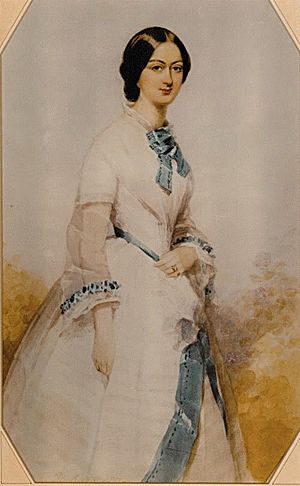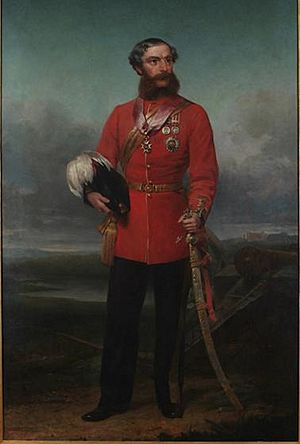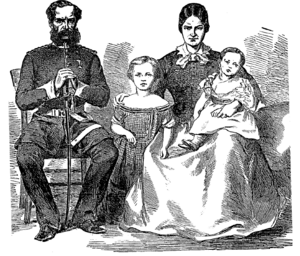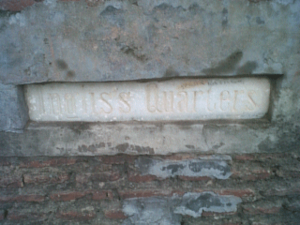Julia, Lady Inglis facts for kids
Quick facts for kids
Julia, Lady Inglis
|
|
|---|---|

Julia Inglis
|
|
| Born |
Julia Selina Thesiger
19 April 1833 |
| Died | 3 February 1904 (aged 70) |
|
Notable work
|
Her diary of the Siege of Lucknow (1857) |
| Spouse(s) | Major-General Sir John Eardley Inglis |
| Children |
|
| Parent(s) | Frederic Thesiger, 1st Baron Chelmsford Anna Maria Tinling |
| Relatives | Frederic Thesiger, 2nd Baron Chelmsford (brother) Alfred Thesiger (brother) |
Julia Selina, Lady Inglis (born April 19, 1833 – died February 3, 1904) was an English writer. She was the daughter of Frederic Thesiger, 1st Baron Chelmsford, a famous lawyer. Julia married Major-General Sir John Eardley Inglis. He was a British army officer.
Julia Inglis is best known for the diary she kept during the Siege of Lucknow in 1857. This was a very difficult time in India. Her diary, called The Siege of Lucknow: a Diary, shares her daily experiences. She wanted to show what the soldiers and people under her husband's command went through.
Contents
Her Family Background
Julia's father, Frederic Thesiger, was a very important lawyer. He became a Member of Parliament. He also served as the top legal advisor for England and Wales. Later, he became a Lord Chancellor, which is a high legal position. He was given the title of the first Baron Chelmsford.
Her mother was Anna Maria Tinling. Anna's uncle, Major Francis Peirson, was a hero. He died defending Jersey from a French attack in 1781.
Julia's older brother, Frederic, also became a Baron. He was a military leader. He led British forces in battles during the Anglo-Zulu War in 1879.
Julia's Own Family
On July 19, 1851, Julia married Lieutenant-Colonel John Eardley Inglis. He was a soldier in the 32nd Regiment of Foot. He had already fought in several battles, including during the Second Anglo-Sikh War.
Julia and John had seven children:
- John Frederic Inglis (born 1852, died as a baby)
- John Frederic Inglis (1853–1923), who was a talented athlete. He played cricket for Kent and football for Wanderers. He even played for Scotland.
- Charles George Inglis (1855–1923), who became a tea planter in Ceylon (now Sri Lanka).
- Alfred Markham Inglis (1856–1919), who also played cricket for Kent.
- Victoria Alexandrina Inglis (1859–1929), who married Hubert Ashton. She was the mother of four famous cricketers: Hubert, Gilbert, Percy, and Claude.
- Julia Mathilda Inglis (1861–1929), who married Sir George Herman Collier. He worked for the India Office.
- Rupert Edward Inglis (1863–1916), who played international rugby for England. He later became a church minister. He served as a chaplain in the First World War and was killed during the Battle of the Somme.
Life During the Siege of Lucknow
In June 1857, Julia Inglis was living in Lucknow, India. She had three young sons, all under five years old. Her husband, Colonel John Inglis, was in charge of the 32nd Foot. This was when the Indian Rebellion began.
On June 30, British forces had to retreat into the residency building in Lucknow. The city was immediately surrounded by rebel forces, starting a long siege. On July 2, the British commander, Sir Henry Lawrence, was badly hurt and died two days later. Colonel Inglis then took command of the defense. He led the British troops until new forces arrived on September 26, 1857.
Julia Inglis kept a detailed diary of her life during the siege. It shows how difficult it was for the British people trapped inside the residency. Julia and her three sons lived in a very small room. It was like a porch, only about twelve feet by six feet. It had no doors or windows, just open arches. She used screens for privacy. Other women were less lucky, living together in large, uncomfortable rooms.
Julia had help from servants, including a cook and a nanny for her children. Many other wives had little or no help.
The diary describes the daily dangers. Movement was risky because of snipers. Julia wrote about fearing the enemy would break in. She also shared how close her husband came to danger. Once, a cannonball missed his bed shortly after he left his room. Another time, a woman was killed by a bullet while helping carry things upstairs.
This evening I was standing outside the door with baby in my arms, talking to the ayah, when I felt something whiz past my ears. I rushed inside, and when my alarm had subsided, ventured out again to discover what it was. I found a large piece of shell embedded about ten inches deep in the earth. It had fallen on the spot where I had been standing. It was a fragment from one of our own shells, which often recoiled and fell inside our entrenchments. (23 July)
Besides attacks, people also suffered from diseases like cholera and small pox. Julia herself had smallpox just before the siege started.
In her diary, Julia often wrote about keeping her "boys" and "baby" (Alfred) safe.
This was Johnny's fourth birthday, a sad one to us all. We managed to get some toys for Johnny from a merchant inside. (16 July)
Johnny was not well to-day, and I feared he might be sickening for small-pox. (31 July)
Johnny's rosy cheeks, which he never lost, excited great admiration; he passed most of his time in the square next to us with the Sikhs, who were very fond of him, and used to give him chappatties (native bread), though they could not have had much to eat themselves, poor men! (28 August)
Mrs. Case and Johnny were walking in the square next to ours to-day, when a Sikh officer passed them, and directly afterwards he was hit in the arm by a bullet. No place was really safe, and I never liked having the children out of my sight. (18 October)
During the siege, we had picked up a little white hen, which used to run about and pick up what it could. Just before Colonel Campbell became so very ill, we had decided to kill and eat it, when one morning Johnny ran in and said, 'Oh, mamma, the white hen has laid an egg!' We took it at once to Colonel Campbell, it being a great luxury in those days. The hen laid one every day for him till he died, and then ceased for the rest of the siege; but we would not kill it then. (12 November)
I had at first put the two boys into a dhoolie with their ayah, but they got separated from us, and it was fully a quarter of an hour before I found them, so I would not let them go from me again. . . poor baby, who was very thirsty, cried louder for it [water] than I had ever heard him before. With difficulty I pacified him, and succeeded in getting him to sleep. (19 November)
After 87 days, the residency was finally reached by General Sir Henry Havelock on September 26.
At 6 pm tremendous cheering was heard, and it was known our relief had reached us. I was standing outside our door when Ellicock rushed in for John's sword; he had not worn it since Chinhut, and a few moments afterwards he came to us accompanied by a short, quiet-looking, gray-haired man, who I knew at once was General Havelock. He shook hands with me, and said he feared we had suffered a great deal. I could hardly answer him – I longed to be with John alone, and he shared my feelings, for erelong he returned to me, and never shall I forget his heartfelt kiss as he said, 'Thank God for this!' Yes, we were safe, and my darling husband spared to me. It was a moment of unmixed happiness, but not lasting. I felt how different my lot was to others.
However, the relief force was not strong enough to get everyone out. Life in the residency continued to be dangerous. Finally, on November 17, more forces arrived under Sir Colin Campbell. Julia wrote that they knew then they were truly "relieved."
Leaving Lucknow

Orders were given to leave the residency. This surprised and saddened the residents. They had held the place for so long. The evacuation started on November 19. Julia felt sad to leave, thinking she might not see her husband for a while.
They passed Secundra Bagh, where many rebels had been killed. Julia felt sick knowing the bodies were so close. They then moved to Dilkusha Park. On November 23, Julia was reunited with her husband. He had stayed behind until the British forces fully left.
The next day, they left Dilkusha Park. They traveled slowly to Alum Bagh. They heard that General Havelock had died. On November 27, they moved towards Cawnpore, a safer city. They reached it on November 29.
But Cawnpore was also under attack. So, on December 3, they left again. They reached Allahabad on December 7. From there, they traveled by boat down the River Ganges to Calcutta. They arrived there on February 6, 1858.
Soon after arriving in Calcutta, Julia learned her husband had been promoted. He was now a major-general. He was honored for his bravery and leadership during the 87-day defense of Lucknow. He also received a special award, becoming a Knight Commander.
A Shipwreck on the Way Home
After the siege, Lady Inglis and her three children sailed back to England. They left Calcutta on February 10, 1858, on a ship called the SS Ava. But on February 16, the ship hit ground near Pigeon Island in Ceylon (now Sri Lanka).
The passengers and crew had to spend a night in the ship's small boats. Julia wrote that her son Johnny was happy when waves broke over the boat. But she thought they might all drown. Luckily, everyone was rescued. The family eventually reached England in early March.
Sir John returned to London on May 20, 1858, and the family was finally together again.
Her Published Diary
In 1892, more than 30 years after the siege, Lady Inglis decided to publish her diary. She hoped it would be interesting to her family and friends. She also wanted to help people understand the defense of Lucknow better. Her diary has been called "absorbing" and "blood-curdling" because of its vivid descriptions.
Later Life
After returning from India, Sir John Inglis was not well. The stress and lack of sleep during the siege had affected his health. He retired from active service. He died on September 27, 1862, at the age of 47.
Lady Inglis later held an honorary position at St James's Palace in London. She lived in Beckenham and passed away there on February 3, 1904.



